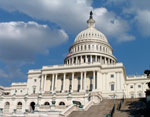Budget Talks Continue, Federal Deficit Smallest Since 2007
Oct 13, 2015
 On October 2, two days after signing the Continuing Resolution (CR) keeping federal programs funded until December 11, President Barack Obama said he would not sign another “shortsighted spending bill.” “We purchased ourselves 10 additional weeks and we need to use them effectively,” President Obama said. Meanwhile, the Congressional Budget Office (CBO) estimates that the federal deficit in FY15 was the lowest it has been since 2007.
On October 2, two days after signing the Continuing Resolution (CR) keeping federal programs funded until December 11, President Barack Obama said he would not sign another “shortsighted spending bill.” “We purchased ourselves 10 additional weeks and we need to use them effectively,” President Obama said. Meanwhile, the Congressional Budget Office (CBO) estimates that the federal deficit in FY15 was the lowest it has been since 2007.
Talks to lift the sequester caps and maintain parity between nondefense and defense programs involve the White House, Senate Majority Leader Mitch McConnell (R-KY), Senate Minority Leader Harry Reid (D-NV), Speaker of the House John Boehner (R-OH), and House Minority Leader Nancy Pelosi (D-CA). Reports from the discussions indicate the possibility of a two-year deal for FY16 and FY17, akin to the “Murray-Ryan” deal that provided a reprieve from the sequester spending caps for FY14 and FY15.
The budget talks could be influenced by the Department of the Treasury’s recent announcement that the extraordinary measures to lift the nation’s debt limit will likely expire on November 5. The debt-limit deadline could compel action on a bipartisan budget agreement. Reaching a spending deal by this date could pave the way for FY16 appropriations bills to be enacted into law before the December 11 deadline. Appropriators have made clear that if they receive a new top line spending limit, they will need at least four weeks to finalize new appropriations bills.
At the U.S. Capitol rally on October 7, NDD United, a broad coalition of organizations representing non-defense discretionary (NDD) programs, hosted a rally to bring attention to the negative impacts of sequestration. The rally was attended by House Minority Whip Steny Hoyer (D-MD) and other members of Congress, who called for a bipartisan budget deal that would bring an end to the sequester cuts.
“Democrats in the House and Senate and Americans across the country are here to send a strong message that the sequester harms our economy and our national security. I am proud to stand with NDD United and with my colleagues from the House and Senate to demand – not to request – to demand that we get on a rational, workable policy,” Representative Hoyer said.
Senator Charles Schumer (D-NY) also spoke at the rally, noting that the cuts required by the sequester spending caps for FY16 are “mindless spending cuts” that will only hurt the economy and increase unemployment,
“Now is the time to act. We’ve done a continuing resolution until December 11, but, frankly, we may have less time than that. By the end of this month, we ought to have a 302(a) allocation that is reasonable, rational, and will help America, not hurt America. We must keep up the pressure for Congress to act,” said Mr. Hoyer.
The 302(a) allocation is the amount the House and Senate Appropriations Committees have to spend on all federal discretionary programs. If the sequester spending caps are raised, the Committees will have increased overall spending limits for FY16. With increased spending limits, discretionary programs, including HUD programs, will have better funding levels than are in the current THUD appropriations bills.
On October 8, the CBO estimated the federal government ran a budget deficit of $435 billion in FY15, the smallest deficit since 2007. “Relative to the size of the economy, that deficit - at an estimated 2.4% of gross domestic product - was slightly below the average experienced over the past 50 years,” the CBO said. The sequester was first imposed by the Budget Control Act of 2011, which was intended to reduce the federal deficit.
The CBO’s report is at: https://www.cbo.gov/sites/default/files/114th-congress-2015-2016/reports/50878-MBR.pdf